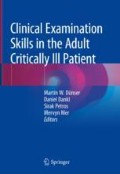Abstract
The history of events yields important information on potential risk factors for severe trauma. Similarly, the mechanism of injury provides comprehensive and invaluable clues which injuries to suspect in a severe trauma patient. Finally, a structured “head-to-toe” examination allows for rapid and reliable recognition of the vast majority of life-threatening injuries. As few other systematic physical examinations in the critically ill, the “head-to-toe” examination in the severe trauma patient must be done in a structured fashion, as the conditions under which it is generally performed are adverse and often stressful (Tables 16.1, 16.2, and 16.4 and Figs. 16.2, 16.3, 16.4, 16.5, 16.6, 16.7, 16.8, and 16.9).
Access this chapter
Tax calculation will be finalised at checkout
Purchases are for personal use only
Reference
Harvey D, Butler J, Groves J et al (2018) Management of perceived devastating brain injury after hospital admission: a consensus statement from stakeholder professional organizations. Br J Anaesth 120:138–145
Author information
Authors and Affiliations
Corresponding author
Editor information
Editors and Affiliations
Clinical Practice
Clinical Practice
Box 1 Checklist Patient History: Severe Trauma
Risk factors for severe/life-threatening trauma
Until proven otherwise, assume severe/life-threatening trauma in every patient who fulfils at least one of the below-mentioned criteria.
Yes | No | |
□ | □ | Fall >6 m (adults) or > 3 m (children <15 years) |
□ | □ | Partial or complete ejection from car? If yes, take particular care to exclude cervical spine fracture! |
□ | □ | “Bullseye”/“spider web” sign present on windscreen (with hair)? If yes, consider traumatic brain injury with associated cervical spine injury |
□ | □ | Death of another passenger in the same vehicle compartment |
□ | □ | Car versus pedestrian/bicyclist thrown, run over or impact with >30 km/h |
□ | □ | Motorcycle crash >30 km/h (>20 mph) |
Additional patient-related information
-
Allergies?
-
Chronic medication (including anticoagulation drugs)?
-
Past medical history (including known bleeding disorder)?
-
Last oral intake?
-
Events leading up to the injury?
Rights and permissions
Copyright information
© 2018 Springer International Publishing AG, part of Springer Nature
About this chapter
Cite this chapter
Dünser, M.W., Dankl, D. (2018). The Patient with Severe Trauma. In: Dünser, M., Dankl, D., Petros, S., Mer, M. (eds) Clinical Examination Skills in the Adult Critically Ill Patient . Springer, Cham. https://doi.org/10.1007/978-3-319-77365-0_16
Download citation
DOI: https://doi.org/10.1007/978-3-319-77365-0_16
Published:
Publisher Name: Springer, Cham
Print ISBN: 978-3-319-77364-3
Online ISBN: 978-3-319-77365-0
eBook Packages: MedicineMedicine (R0)

